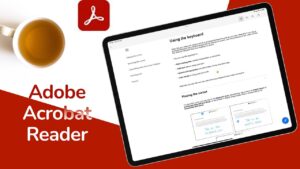Adobe Acrobat Studio with AI Assistants: Reinventing Productivity, Creativity, and Collaboration
Introduction
Adobe has always been at the forefront of digital transformation. From Photoshop to Illustrator to Acrobat, its tools have defined how people create, share, and interact with digital content. In 2025, Adobe raised the bar again with the introduction of Adobe Acrobat Studio with AI Assistants—a groundbreaking evolution of the PDF ecosystem.
This isn’t just a redesign of Acrobat; it’s a full rethinking of document workflows powered by generative AI assistants. Acrobat Studio transforms PDFs from static documents into intelligent, interactive spaces where text, visuals, data, and AI come together seamlessly.
In this article, we’ll explore:
-
What Adobe Acrobat Studio with AI Assistants is.
-
The core features that make it revolutionary.
-
How it is changing business productivity, education, and creative industries.
-
The competitive landscape with Microsoft Copilot, Google Duet AI, and Apple Intelligence.
-
The ethical, privacy, and future implications of AI-powered document ecosystems.
Let’s dive deep into how Adobe is reinventing its most iconic product for the AI era.
What is Adobe Acrobat Studio with AI Assistants?
Adobe Acrobat Studio is the next-generation evolution of Acrobat, powered by Adobe Sensei GenAI. It integrates multiple AI assistants into the PDF workspace, turning documents into dynamic environments that can:
-
Summarize lengthy contracts or reports.
-
Generate content such as presentations, slides, and infographics from PDFs.
-
Collaborate in real time by suggesting edits, rewrites, and annotations.
-
Extract structured data for spreadsheets and analytics.
-
Answer questions about document content conversationally.
In essence, Acrobat Studio is Microsoft Word meets ChatGPT meets Canva—inside a PDF. It makes working with documents less about reading static files and more about interacting with living, intelligent documents.
Core Features of Adobe Acrobat Studio with AI Assistants
1. Conversational Document Interaction
Instead of scrolling through hundreds of pages, users can chat with their PDFs. For example:
-
A lawyer can ask: “Summarize the liability clauses in this contract.”
-
A student can ask: “What are the three main arguments in this research paper?”
-
A business analyst can ask: “Highlight all references to revenue growth between 2020–2024.”
This transforms PDFs from passive files into knowledgeable collaborators.
2. AI-Powered Summaries & Insights
Acrobat Studio can generate:
-
Executive summaries of reports.
-
Key insights extracted from research.
-
Highlights with priority ranking for decision-making.
This eliminates hours of manual reading and note-taking.
3. Smart Formatting & Content Generation
The AI assistants can reformat PDFs into other content types:
-
Turn a whitepaper into a slide deck.
-
Convert meeting notes into a polished proposal.
-
Translate a contract into plain English for easier understanding.
4. Data Extraction & Analytics
One of the most powerful features is AI-driven data extraction. Instead of manually copying tables from PDFs, Acrobat Studio can:
-
Export data directly into Excel or Google Sheets.
-
Detect financial, legal, or scientific data automatically.
-
Apply statistical analysis to numbers inside a PDF.
5. Integrated Collaboration
Multiple people can collaborate with AI inside the same document. Imagine a group project where:
-
One student summarizes content.
-
Another verifies citations.
-
An AI assistant organizes everything into a structured report.
This real-time collaboration turns Acrobat Studio into a virtual workplace hub.
6. Multilingual AI Translation
With globalization, many users handle documents in multiple languages. Acrobat Studio supports real-time translation with AI assistants that maintain formatting and context.
Adobe Acrobat Studio in Action: Real-World Use Cases
1. Business Productivity
-
Legal Teams: AI can flag problematic clauses, suggest edits, and generate summaries.
-
Finance Teams: Extract quarterly financials, detect anomalies, and compare trends.
-
HR Teams: Rewrite job contracts, summarize policy updates, and translate compliance documents.
2. Education & Research
-
Students can use Acrobat Studio to summarize research papers, annotate reading materials, and create study notes.
-
Teachers can generate quizzes, lesson summaries, and grading rubrics directly from PDFs.
-
Researchers can extract datasets and cross-reference citations automatically.
3. Creative Industries
-
Marketers can turn reports into presentation decks.
-
Designers can extract visuals and repurpose them for campaigns.
-
Writers can brainstorm new ideas by prompting the AI to expand document concepts.
4. Government & Policy
Government agencies deal with long, complex PDFs: legislation, census reports, regulatory frameworks. Acrobat Studio can:
-
Simplify laws into plain English for citizens.
-
Highlight key changes between different policy versions.
-
Translate official documents for multilingual access.
Acrobat Studio vs Competitors: Microsoft, Google, Apple
The rise of AI assistants in productivity suites makes Acrobat Studio part of a competitive ecosystem.
-
Microsoft Copilot: Deeply integrated into Word, Excel, and Teams. Acrobat Studio competes by offering native PDF intelligence, where Microsoft still relies on third-party integrations.
-
Google Duet AI: Strong collaboration features in Docs and Slides, but weaker in PDF-native workflows.
-
Apple Intelligence: Personal device-level AI with privacy-first design. Adobe complements this by focusing on document ecosystems rather than OS-level AI.
Adobe’s advantage lies in its long-standing dominance in the PDF format. By infusing AI assistants directly into PDFs, it secures its role as the de facto leader of intelligent documents.
Ethical and Privacy Considerations
With AI assistants handling confidential documents, privacy and ethics become crucial. Adobe has addressed this through:
-
On-device processing for sensitive documents.
-
Enterprise-grade encryption for cloud workflows.
-
Custom AI models that don’t train on user data without consent.
-
Audit trails for businesses that need transparency.
Still, challenges remain. For example:
-
Could AI assistants misinterpret legal clauses and create liabilities?
-
Will employees over-rely on AI, reducing critical thinking?
-
Can Adobe maintain global compliance with evolving AI regulations?
These are ongoing questions, but Adobe is clearly betting that trustworthy AI will differentiate Acrobat Studio.
The Future of Acrobat Studio with AI Assistants
Adobe Acrobat Studio is only the beginning of AI-native documents. Looking ahead:
-
Multi-Agent Collaboration
-
Imagine multiple AI assistants specialized in law, finance, and design working together in one document.
-
-
Voice-Enabled AI Assistants
-
Users may interact with PDFs through voice commands.
-
-
Adaptive Personalization
-
Acrobat Studio could learn a user’s workflow style, offering personalized recommendations.
-
-
Integration with AR/VR
-
Future documents may become immersive experiences, not just 2D files.
-
In other words, Acrobat Studio sets the foundation for a post-document future where files evolve into intelligent workspaces.
Final Thoughts
Adobe Acrobat Studio with AI Assistants is more than an upgrade; it’s a paradigm shift in how we work with documents. By combining the reliability of PDFs with the power of generative AI, Adobe has turned its most enduring product into a 21st-century productivity platform.
Whether you’re a student, lawyer, researcher, or business executive, Acrobat Studio promises:
-
Faster workflows
-
Smarter insights
-
Collaborative intelligence
Just as Photoshop transformed images, Acrobat Studio is set to transform documents. And in doing so, Adobe has once again positioned itself at the center of the digital productivity revolution.
https://bitsofall.com/nvidia-new-chip-for-china-ai-supply-chain/
Amazon’s AI Investment: How the Retail Giant Is Rewiring the Cloud, Chips, and the Future of Work






